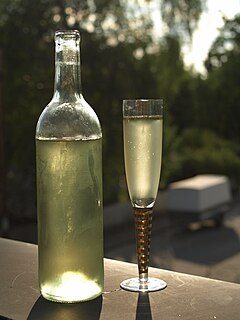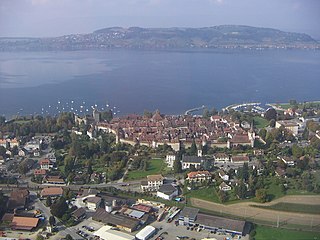
Mead is an alcoholic beverage created by fermenting honey with water, sometimes with various fruits, spices, grains, or hops. The alcoholic content ranges from about 3.5% ABV to more than 20%. The defining characteristic of mead is that the majority of the beverage's fermentable sugar is derived from honey. It may be still, carbonated, or naturally sparkling; dry, semi-sweet, or sweet.

The canton of Fribourg, also canton of Friburg is located in western Switzerland. The canton is bilingual, with French spoken by two thirds of the citizens and German by about one third. Both are official languages in the canton. The canton takes its name from its capital city of Fribourg.

Lake Bienne, or Lake Biel is a lake in western Switzerland. Together with Lake Morat and Lake Neuchâtel, it is one of the three large lakes in the Jura region of Switzerland. It lies approximately at 47°5′N7°10′E, at the language boundary between German and French speaking areas.

Lake Morat or Lake Murten is a lake located in the cantons of Fribourg and Vaud in the west of Switzerland. It is named after the small bilingual town of Murten/Morat on its southern shore.

Münchenwiler is a municipality in the Bern-Mittelland administrative district in the canton of Bern in Switzerland.
Expo.02 was the 6th Swiss national exposition, which was held from 15 May to 20 October 2002. The exposition took place around the lakes of Neuchâtel, Bienne/Biel and Morat/Murten. It was divided into five sites, which were called Arteplages, due to the proximity of the water. The five arteplages were located in Neuchâtel, Yverdon-les-Bains, Morat/Murten, Biel/Bienne and on a mobile barge traveling from one site to another. The barge represented the canton of Jura, which does not have access to any one of the three lakes.

Murten (German) or Morat (French) is a bilingual municipality in the See district of the canton of Fribourg in Switzerland.

Romandy is the French-speaking part of western Switzerland. In 2018, about 2.1 million people, or 25.1% of the Swiss population, lived in Romandy. The majority of the romand population lives in the western part of the country, especially the Arc Lémanique region along Lake Geneva, connecting Geneva, Vaud and the Lower Valais.

The Battle of Morat was a battle in the Burgundian Wars (1474–77) that was fought on 22 June 1476 between Charles the Bold, the Duke of Burgundy, and a Swiss Confederate army at Morat/Murten, about 30 kilometres from Bern. The result was a crushing defeat for the Burgundians at the hands of the Swiss.

Röstigraben is a humorous term used to refer to the cultural boundary between German-speaking and French-speaking parts of Switzerland. There is also a term Polentagraben which refers to the Italian-speaking canton of Ticino.

The Broye is a 68 km long river, in the cantons of Fribourg and Vaud, in Switzerland. It has a watershed area of 850 km².
The Gruyère–Fribourg–Morat railway (GFM) was established with the merger in 1942 of two standard gauge and one 1,000 mm gauge railways running mainly within the Swiss canton of Fribourg. It was officially called the Compagnie des Chemins de fer fribourgeois. The company also operated numerous regional buses in the same area. After a merger with Fribourg city transport, the company was renamed Transports publics fribourgeois/Freiburgische Verkehrsbetriebe (TPF).
See or Lac District is one of the seven districts of the canton of Fribourg in Switzerland. Lying to the north of the canton, the district is bilingual (French/German). Its territory enclaves the two Bernese municipalities of Münchenwiler and Clavaleyres, while its own village of Wallenbuch is exclaved within Bern. It has a population of 36,800.

The Battle of Nancy was the final and decisive battle of the Burgundian Wars, fought outside the walls of Nancy on 5 January 1477 by Charles the Bold, Duke of Burgundy, against René II, Duke of Lorraine, and the Swiss Confederacy.
Grand Marais in Seeland is a region in Switzerland, at the foot of the first mountain range of the Jura Mountains contained by the three lakes of Morat (Murten), Neuchâtel and Bienne (Biel). Before the huge hydrological works Jura water correction, it was a marshland that covered 62.5 km2 (24.1 sq mi). Before the correction the entire Grand Marais, along with the whole Seeland was prone to very severe recurring floods.
Events from the year 1476 in France

The Palézieux–Lyss railway is a single-track standard-gauge line of the Swiss Federal Railways (SBB) in Romandy.
The Fribourg–Ins railway is a single-track standard-gauge line in Switzerland operated by Transports publics Fribourgeois. It was built by the Chemin de fer Fribourg–Morat–Anet.

Morat is a Colombian band formed in the country's capital city, Bogotá. The band is formed by Juan Pablo Isaza, Juan Pablo Villamil and the brothers Simón Vargas and Martín Vargas. Previously, until the end of 2016, drummer Alejandro Posada had been in the band, but the percussionist had to leave the project, who was replaced by Martín Vargas.











